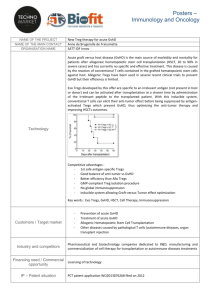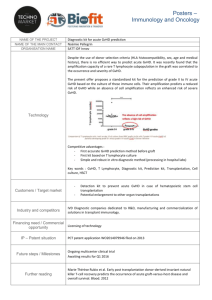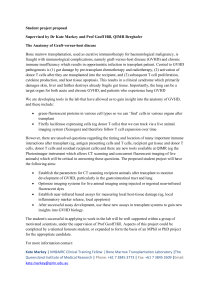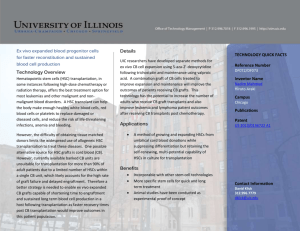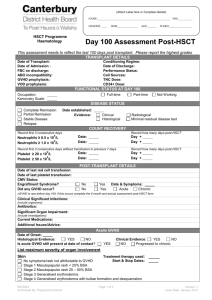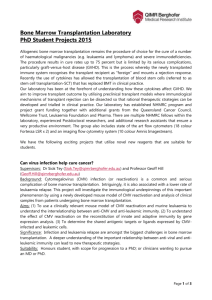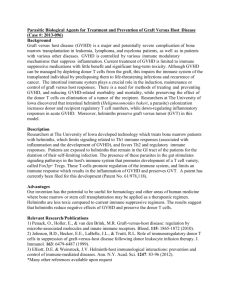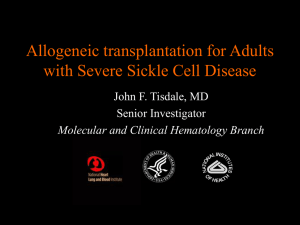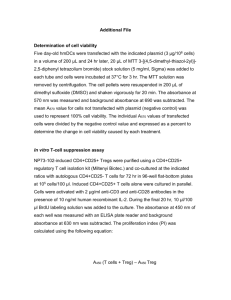Novel regulatory therapies for prevention of GVHD1 Joseph
advertisement
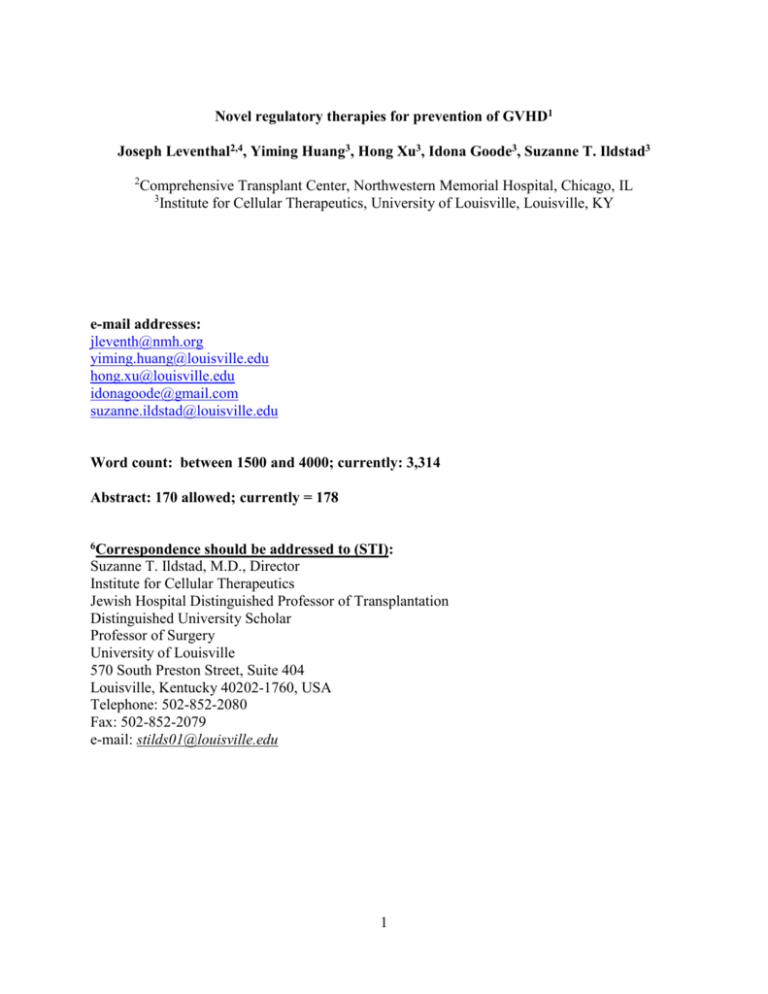
Novel regulatory therapies for prevention of GVHD1
Joseph Leventhal2,4, Yiming Huang3, Hong Xu3, Idona Goode3, Suzanne T. Ildstad3
2
Comprehensive Transplant Center, Northwestern Memorial Hospital, Chicago, IL
3
Institute for Cellular Therapeutics, University of Louisville, Louisville, KY
e-mail addresses:
jleventh@nmh.org
yiming.huang@louisville.edu
hong.xu@louisville.edu
idonagoode@gmail.com
suzanne.ildstad@louisville.edu
Word count: between 1500 and 4000; currently: 3,314
Abstract: 170 allowed; currently = 178
6Correspondence
should be addressed to (STI):
Suzanne T. Ildstad, M.D., Director
Institute for Cellular Therapeutics
Jewish Hospital Distinguished Professor of Transplantation
Distinguished University Scholar
Professor of Surgery
University of Louisville
570 South Preston Street, Suite 404
Louisville, Kentucky 40202-1760, USA
Telephone: 502-852-2080
Fax: 502-852-2079
e-mail: stilds01@louisville.edu
1
ABSTRACT
Graft-versus-host disease (GVHD) is one of the major transplant-related complications in
allogeneic hematopoietic stem cell transplantation. Continued efforts have been made to prevent
the occurrence of severe graft-versus-host disease by eliminating or suppressing donor-derived
effector T cells. Conventional immunosuppression does not adequately prevent graft-versus-host
disease, especially in mismatched transplants. Unfortunately, elimination of donor-derived T
cells impairs stem cell engraftment, and delays immunologic reconstitution, rendering the
recipient susceptible to post-transplant infections and disease relapse, with potentially lethal
consequences. In this review, we discuss the role of dynamic immune regulation in controlling
GVHD, and how cell based therapies are being developed using regulatory T cells and other
tolerogenic cells for the prevention and treatment of GVHD. In addition, advances in the design
of cytoreductive conditioning regimens to selectively target GVHD-inducing donor-derived T
cells that have improved the safety of allogeneic stem cell transplantation are reviewed. Finally,
we discuss advances in our understanding of the tolerogenic facilitating cell population, a
phenotypically and functionally distinct population of bone marrow-derived cells which promote
hematopoietic stem cell engraftment while reducing the risk of GVHD.
2
REVIEW
Regulatory T cells in GVHD-prevention
Graft-versus-host disease (GVHD) remains a major obstacle for the clinical application
of hematopoietic stem cell (HSC) transplantation [1]. GVHD is initiated by alloreactive donor T
cells which recognize the host major and minor histocompatibility antigens, proliferate, and
damage target tissues.
Donor T cells have been shown to enhance engraftment of HSC,
reconstitute T cell immunity, and mediate a potent beneficial anti-tumor effect, known as graftversus-leukemia (GVL) effect. Depletion of donor T cells impairs engraftment of HSC and
abrogates the T cell-mediated GVL effect. In addition, administration of immunosuppressive
drugs to prevent GVHD after HSC transplantation impairs T cell function and increases the risk
of opportunistic infection and tumor relapse. Therefore, recent approaches have focused on
tailored approaches to maintain the desirable effect of GVL yet avoid GVHD following HSC
transplantation. Recent pre-clinical novel cell-based therapies have been developed to achieve
these outcomes. They are currently being translated to the clinic.
The mechanisms of donor T cell (CD4+ T cell and CD8+ T cell)-mediated GVHD are
multifactorial and include: 1) activation of macrophages and antigen-presenting cells (APC) by
transplantation conditioning regimens to damage host tissue, releasing soluble cytokines such as
tumor necrosis factors (TNF)-α
and interleukin-1 (IL-1); 2) alloreactive T cell activation,
proliferation, and differentiation in response to host or donor APC; and 3) alloreactive T cell
infiltration and release of pro-inflammatory cytokines which leads to damage of the target tissue
[2]. Over the past two decades, the importance of regulatory populations of lymphocytes in
controlling immune responses has been increasingly appreciated. Although different cell subsets
with regulatory activity have been described, including CD4+/CD25+/FoxP3+, CD8+/CD28-,
3
T/NK cells, and TCR+/CD4-/CD8-, most studies have concentrated on CD4+/CD25+/FoxP3+ T
cells [3]. Among the CD4+ T cell population, the CD4+/CD25+/FoxP3+ regulatory T cell (Treg)
have been demonstrated to suppress a variety of effector T cell dependent immune responses.
CD4+ Treg have been divided into two major groups: the naturally occurring Treg and
inducible Treg. Both types of Treg have proven effective in preventing GVHD in murine models
of GVHD [4, 5] and to a lesser extent in human HSC transplantation [6-8]. Although studies
have suggested that Treg downregulate both T helper (Th1) and Th2-mediated immune responses
mainly through IL-10 and TGF-β production, direct cell-cell contact has also been postulated to
be required as a mechanism of action. Natural Treg are generated in the thymus and are nonspecific in their suppressive capability [3, 9]. Although natural Treg must encounter antigen to
exert their suppressive effects, once activated they suppress in an antigen-nonspecific manner,
presumably through the release of immunosuppressive cytokines including IL-10 and TGF-β
[10]. Because of their non-specific mechanism of action, there is concern regarding their clinical
relevance. Importantly, antigen specific Treg cells are inducible and need to be activated through
their TCR in order to mediate their suppressive activities. The expression of receptors of
chemokines such as CCR5 and CXCR3 on antigen-specific Treg support a role for proper
trafficking of Treg to target tissue in prevention of acute GVHD in murine models [11, 12]. A
recent study showed that tolerant patients without GVHD following HSCT expressed
significantly higher levels of CXCR3 and CCR5 compared to patients with acute GVHD early
after HSC transplantation [8], suggesting that homing of Treg to secondary lymphoid tissues and
sites of inflammation may play an important role in control of GVHD.
Several studies in experimental murine models have shown that Treg can suppress
proliferative activity of conventional CD4+ T cells and CD8+ T cells to alloantigenic stimulation
4
in vitro and induce transplantation tolerance and reduce acute GVHD occurrence in vivo [13-15].
Donor CD4+/CD25+ Treg isolated from spleen or bone marrow of C57BL/6 mice can suppress
lethal GVHD induced by transplanted donor CD4+/CD25- T effector cells after allogeneic T celldepleted bone marrow transplantation (BMT) [14].
Importantly, the beneficial effect of
adoptively transferred CD4+/CD25+ Treg does not abrogate the beneficial effect of donor T cellmediated GVL [13]. Ianni et al. recently evaluated the impact of early infusion of freshly
isolated human donor CD4+/CD25+ Treg followed by conventional T cells in human leukocyte
antigen (HLA)-haploidentical HSCT [16]. Adoptive transfer of human donor Treg prevented
acute as well as chronic GVHD in the absence of immunosuppressive drug therapy after
transplantation. Moreover, Treg promoted immune reconstitution of CD4+ T cells, CD8+ T cells,
B cells, and NK cells, and improved protective immunity against CMV infection.
The major limitation for the clinical application of Treg-based therapy to prevent GVHD
is obtaining a sufficient numbers of antigen-specific Treg and maintaining their regulatory
properties after infusion [17]. Studies showed that ex vivo expansion of mouse recipient-specific
CD4+/CD25+ Treg can be obtained using donor Treg stimulation with allogeneic recipient APC [18,
19]. Ex vivo expansion of Treg resulted in specific-tolerance for recipient-type alloantigens, but
not for third-party antigens. Moreover, the Treg effectively controlled GVHD while favoring
immune reconstitution and maintaining GVL in murine model [18]. Another study showed that
rapamycin-induced Treg from human CD4+/CD25-/CD45RA+ cells exhibit a potent suppressive
function in vitro compared to natural Treg, and suppress acute GVHD in a xenogeneic
NOD/SCID mouse model [20]. Clinical trials of therapeutic cell transfer using Treg for the
prevention and/or treatment of GVHD have been recently described. Ianni et al. reported that the
adoptive transfer of freshly isolated, donor-derived natural Treg followed by conventional donor-
5
derived T cells (Tcon) at the time of full-haplotype–mismatched adult HSCT in patients being
treated for hematologic malignancies prevented acute or chronic GVHD while favoring Tconmediated post-transplantation immune reconstitution [16]. Brunstein et al. have detailed a “firstin-human” phase 1 clinical trial of nonspecific (CD3/CD28 bead)-based, ex vivo expanded
umbilical cord blood (UCB)-derived Treg in patients after UCB transplantation and noted a
reduced incidence of severe acute GVHD [21].
Treg as a diagnostic and prognostic cellular biomarker for acute GVHD has been
investigated in mouse and rat models and human HSCT [22-25]. Studies reported that the level
of FoxP3 mRNA expression in peripheral blood mononuclear cells from patients with either
acute GVHD or chronic GVHD was significantly decreased compared with patients without
GVHD [25, 26], suggesting that a regulatory mechanism is involved in the development of
GVHD. The number of FoxP3+ Treg in skin biopsies from GVHD patients was significantly
higher in patients responding to GVHD treatment and with a lower grade of GVHD compared to
those with more severe GVHD [23]. Taken together, these observations indicate that Treg can
regulate immune responses and induce tolerance to alloantigen after HSCT. These findings
provide evidence for the use of Treg as a useful biologic to improve GVHD diagnosis and
treatment.
Cyclophosphamide (CyP) and prevention of GVHD
In GVHD, functional immune cells in the donor bone marrow recognize the recipient as
"foreign" and mount an immunologic attack to the patient's organs and tissues, impairing their
ability to function [1]. Strict HLA matching between donors and transplant patients has been
proven to reduce the incidence and severity of GVHD [27]. However, approximately 50 percent
of patients still develop GVHD even if they undergo allogeneic HSCT with HLA-matched
6
donors [28]. The challenge facing HSCT is to achieve better allogeneic engraftment without
graft rejection and GVHD. The common reagents of GVHD prophylaxis comprise cyclosporine,
or tacrolimus, methotrexate, mycophenolate mofetil (MMF), or sirolimus [29-31]. However,
cyclophosphamide has been found more recently in animal and clinical studies to be a better and
potent prophylactic agent of GVHD without obvious aplasia due to toxicity to donor stem cells
[32-36]. When it is used in high dose post allogeneic BMT in mouse models, cyclophosphamide
targets alloreactive proliferating T cells and enhances alloengraftment without causing GVHD
[32-34]. Therefore, in order to gain the effect of CyP in enhancing alloengraftment, it has to be
used 48 hours post-BMC infusion but not before [32]. High-dose CyP given on day 2 after
transplantation mitigated both the incidence and severity of acute GVHD in a major
histocompatibility complex (MHC)-mismatched donor-recipient combination [37]. The effect of
post-transplantation CyP in GVHD prevention has been demonstrated by inhibiting graft vs. host
reactions and selectively eliminating activated T cells in response to donor antigens in minor
histocompatibility disparity [38] and MHC-mismatched [33] mouse models. Clinically, posttransplantation CyP has reduced the incidence and severity of GVHD across MHC barriers after
BMT [33-35, 39, 40]. High expression of aldehyde dehydrogenase in HSC allows for the prompt
inactivation of CyP and helps explains their relative resistance to the effects of this alkylating
agent. In contrast, activated lymphocytes express low levels of aldehyde dehydrogenase and are
particularly susceptible to CyP. Importantly, these preclinical studies demonstrated the specific
safety profile of CyP in stem cell-sparing activity, thus provided the pre-clinical rationale to
proceed with a clinical trial of partially HLA-mismatched, or HLA-haploidentical, BMT with
high-dose post-transplantation CyP for patients with poor prognosis hematologic malignancies.
7
The major clinical rationale for HLA-haploidentical BMT is to extend the potential
benefits of HSCT and the graft-versus-tumor effect to patients who lack an HLA-matched donor.
The major challenge is to reduce the incidence of fatal graft rejection, severe GVHD, and
treatment-related mortality while promoting engraftment. Luznik et al. recently reported the
outcomes of 68 patients with poor-risk hematologic malignancies who were conditioned with
fludarabine, CyP and 2 Gy total body irradiation (TBI) prior to receiving T cell-replete bone
marrow from HLA-haploidentical, first-degree relatives [36].
Donors and recipients were
mismatched at a median of 4 out of 5 HLA alleles indicating substantial donor–recipient
histoincompatibility. GVHD prophylaxis comprised CyP 50 mg/kg IV on day 3 (n = 28) or on
days 3 and 4 (n = 40) after transplantation, followed by tacrolimus and MMF. These two drugs
were included to provide extra protection against graft failure and GVHD and were started after
the completion of CyP in light of preclinical data that calcineurin inhibitors block CyP-induced
transplantation tolerance by blocking the activation and proliferation of alloreactive T cells [41].
Recovery of neutrophils and platelets occurred at a median of 15 and 24 days, respectively, after
transplantation. Graft failure occurred in nine patients (13%). Acute grades II–IV and III–IV
GVHD occurred in 34% and 6% of patients, respectively, and chronic GVHD developed in 15%
of patients. These rates of GVHD-development are comparable to or below the incidences of
acute and chronic GVHD after HLA-matched HSCT without post-transplantation CyP [42]. The
cumulative incidences of relapse and non-relapse mortality at 1 year after transplantation were
51% and 15%, respectively, and overall survival and event-free survival at 2 years after
transplantation were 36 and 26%. Only six patients died of infection (n = 4) or GVHD (n = 2).
These data support the safety and potential efficacy of post-transplantation CyP in preventing
GVHD and fatal graft rejection after HLA-haploidentical HSCT.
8
Based upon the results of Luznik and Fuchs [35, 36, 39], we have included the use of
post-transplant CyP (50 mg/kg day +3) as part of a nonmyeloablative conditioning regimen
being used in ongoing phase 2 trial of tolerance induction in recipients of mismatched kidney
and stem cell transplants. Durable donor chimerism has been achieved in 5 of the first 8 subjects
and no patient has developed GVHD (manuscript In Press, Science of Translational Medicine
2012).
The Facilitating Cell (FC): key regulator of stem cell engraftment
T cell depletion (TCD) of allogeneic BM is extremely effective at reducing the risk of
GVHD, but greatly increases the risk of engraftment failure [43].
Three possible reasons for
TCD-associated-engraftment failure have been hypothesized: 1) HSC can engraft across MHC
matched but minor disparate barriers, but fail to engraft in allogeneic recipients because they are
harmed or removed during TCD; 2) T cells act as essential partner cells to promote allogeneic
HSC engraftment; 3) an additional BM population, which shares some T cell markers, protects
the HSC from rejection or “facilitates” HSC engraftment, but is inadvertently removed as an
“innocent bystander” during TCD. Investigations in different laboratories have provided strong
evidence in support of the latter hypothesis. Initial studies in mice using different cell subsets
sorted from donor BM identified a distinct population of CD8+/TCR- FC capable of promoting
allogeneic HSC engraftment and establishment of mixed chimerism [44]. The addition of 30,000
MHC matched purified FC to as few as 10,000 donor HSC into ablated MHC-disparate B10
recipients resulted in stable allogeneic engraftment across both class I and class II barriers,
without causing GVHD [44]. Transplantation of FC alone failed to rescue recipients, indicating
that FC are not an HSC. Importantly, FC + HSC reconstituted animals exhibit donor-specific
tolerance for skin, cardiac and islet grafts.
9
In light of the fact that FC function is distinct from that demonstrated by BM-derived
mature T cells, much research has gone into identifying the resident cell subpopulations that
constitute this rare facilitating population. Previous studies have shown that the CD8+/TCR- FC
population shares phenotypic characteristics with CD8α plasmacytoid precursor dendritic cells
(p-preDC) and that FC total are heterogeneous in morphology [45]. A comprehensive assessment
of FC surface markers using flow cytometric analysis of sorted FC populations by Fugier-Vivier
et al. [46] revealed a broad heterogeneity in sub-populations with facilitating potential. The
majority of CD8+/TCR- FC were positive for CD11c+ (65-70%) and B220+ (75-88%) expression.
While only 15% of the B220+ population was composed of B cells, 55% co-expressed CD11c
(CD11c+/B220+), suggestive of a DC component. Further analysis into this CD11c+ dendritic
subset revealed that a p-preDC phenotype (CD11dim/B220+/CD11b-) is the predominant cell type
(93–95%) within this CD11c+ subset (Figure 1). The functionality of this p-preDC-like subset of
the FC has been assessed by transplanting these cells with HSC into ablated murine allogeneic
recipients. The co-transplantation of p-preDC rescues allogeneic recipients from radiation aplasia,
significantly enhancing alloengraftment and survival compared with ablated recipients that
received HSC alone. However, facilitation by this p-preDC component alone was inferior to that
observed when the entire FC population was utilized. This observation suggests that the p-pre
DC subset is necessary, but not sufficient, for HSC facilitation and cannot fully replace the total
FC population. Other elegant studies by Colson et al. indicate that CD3ε expression by FC and
the association of CD3ε with TCRβ chain and a novel 33kDa protein termed FCp33 is critical for
the HSC engraftment enhancing properties of FC [47].
Recent studies have focused on exploring the FC and seeking to understand its role in
generating tolerance. One such study completed on mice consisted of three groups of purified
10
bone marrow inocula, which contained different subsets of CD8+ cells that were administered to
semi-allogeneic recipient mice [48]. The first group was -TCR+ splenic T cells, the second
group was the CD8+/TCR+ BM-derived T cells, and the third group was the BM-derived
CD8+/TCR- FC population. The purpose behind this experimental setup was to determine which
group of cells would induce GVHD in the recipient mice. There were several important findings
that resulted from this study [48]. The first was disproving the common belief that administering
donor CD8+ T cells would enhance engraftment and prevent the development of GVHD. This
idea is supported by the fact that mice in the first and second groups of the experiment developed
lethal GVHD, while mice in the group that received facilitating cells failed to develop clinical
symptoms or histological evidence of GVHD [48]. Additionally, the researchers reported failure
of FC to induce GVHD in mice when the number of FC transplanted was increased from 50,000
to 400,000 confirming that FC lack GVHD effector activity. Researchers also explored the
mechanism behind the lack of GVHD development with transplantation of FC versus
transplantation of the CD8+/TCR+ bone marrow cells [48]. The results from such studies found
an increase in the expression of T cell-mediated immunosuppression factors. In particular, mice
that received HSC with FC showed a significant increase in transcription of TGF-, a cytokine
known to be a key player in the induction and development of Treg.
There was also a
considerable increase in the expression of the cyte-associated antigen 4 (CTLA-4),
glucocorticoid-induced TNF receptor, and forkhead/winged helix transcription factor (FoxP3)
genes, which are associated with Treg and suppressor T cell function. It was concluded that FC
induce the formation of immunoregulatory T cells in vivo, since the FC is not a Treg and does not
express the genes linked to Treg [48].
11
The ability of FC to induce the formation of CD4+/CD25+ Treg from naive CD4+/CD25- T
cells, as shown in one recent study, is another proposed mechanism of how FC promote
tolerance [49]. CD4+/CD25+ Treg cells have been found to promote bone marrow engraftment
and chimerism when transplanted into irradiated recipients [49]. Additionally, CD4+/CD25+
cells are thought to prevent the development of GVHD after allogeneic transplantation. Both of
these observations are similar to those observed with BM transplantation containing FC. This
has lead researchers to consider an association between FC and CD4+/CD25+ Treg in inducing
tolerance and preventing GVHD [49].
It was believed that p-preDC were the primary activators of naive CD4+/CD25- T cells;
however, Taylor et al. have shown that FC possess this function as well [49]. The Taylor study
involved mice receiving an allogeneic HSC plus FC transplant and measuring the induction of
FoxP3+/CD4+/CD25+ by FC. Three major observations were made by this group that expanded
the scientific knowledge of FC. The first was that donor FC were observed in the spleen shortly
after transplantation and the induction of donor FoxP3+/CD4+/CD25+ Treg also occurred in the
spleen. Since p-preDC activate Treg in the spleen, the presence of FC in the spleen prior to
activation of Treg supports the notion that FC activate Treg. The second was the observation that
FC could induce the formation of FoxP3+/CD4+/CD25+ Treg from CD4+/CD25- T cells in coculture. Similar to p-preDC, researchers proposed a similar mechanism of activation of FC to
generate FoxP3+/CD4+/CD25+ T cells. However, higher levels of IL-4 gene expression were
observed with FC-generated CD4+/CD25+ T cells in comparison to p-preDC generated T cells
[49]. The last significant observation was that FC required direct cell-to-cell contact to induce
the formation of FoxP3+/CD4+/CD25+ Treg. Fewer FoxP3+/CD4+/CD25+ cells were produced in
the absence of physical contact than when direct contact occurred between the FC and the
12
CD4+/CD25- T cell [49]. Recent studies have suggested that the differentiation of CD4+/CD25T cells into CD4+/CD25+ T cells requires stimulation from various sources [49]. The B7 receptor
is one important aspect of this activation process since studies have demonstrated a lower
number of CD4+/CD25+ T cells in mice with a B7 deficiency [49]. CD86 is thought be another
important player in assisting FC to produce FoxP3+/CD4+/CD25+ Treg since its presence is
required for differentiation [49]. More recently, FC have been shown to induce antigen-specific
Treg in vivo (Figure 2) [50]. Transplantation of FC plus HSC into conditioned allogeneic mouse
recipients followed by harvest of CD4+/CD25+ Treg from the spleen of chimeras (chimeric Treg),
and secondary transplantation of the Treg with donor HSC plus third-party HSC resulted in
engraftment of only the donor HSC, demonstrating antigen-specificity.
In recent years, there have been significant advances in understanding the mechanism of
FC function which have provided additional support for the promising potential for FC to be
used in the clinic to generate tolerance after HSCT. Data collected from recent studies have
helped to distinguish FC from other hematopoietic cells such as p-preDC. However, there are
questions that remain to be answered regarding the role of FC in inducing tolerance, preventing
GVHD, and promoting chimerism following BM transplantation. An FDA approved phase 2
clinical study is currently underway to test the use of FC-based HSCT in recipients of living
donor renal allografts.
Preliminary findings have demonstrated that high levels of donor
macrochimerism without GVHD can be established in mismatched recipients conditioned with
fludarabine, CyP and 200 cGy TBI [51].
CONCLUSION
In conclusion, the use of cell-based therapies in prevention and treatment of GVHD is
now being applied in a number of clinical protocols, with promising results. Cell-based therapies
13
have the potential to promote engraftment, preserve immunocompetence, and prevent GVHD,
thereby avoiding the toxicity of broad acting non-specific immunosuppressive agents.
14
LIST OF ABBREVIATIONS
antigen-presenting cells (APC)
conventional donor-derived T cells (Tcon)
cyclophosphamide (CyP)
dendritic cells (DC)
facilitating cell (FC)
graft-versus-host disease (GVHD)
graft-versus-leukemia (GVL)
hematopoietic stem cell transplantation (HSCT)
human leukocyte antigen (HLA)
interleukin (IL)
major histocompatibility complex (MHC)
plasmacytoid precursor dendritic cells (p-preDC)
regulatory T cell (Treg)
T cell depletion (TCD)
total body irradiation (TBI)
tumor necrosis factors (TNF)
umbilical cord blood (UCB)
15
COMPETING INTERESTS: Dr. Suzanne Ildstad has significant equity interest in Regenerex,
LLC, a start-up biotech company based on the facilitating cell technology. All other authors
have no conflict of interest to declare.
AUTHOR’S CONTRIBUTIONS: JL: overall preparation and editing of review; YH: studies
on role of Treg cells in GVHD prevention; HX: studies on role of cyclophosphamide; IG: review
of FC mechanism of action; STI: overall editing and preparation of review
ACKNOWLEDGMENTS and FUNDING
The authors thank Dr. Haval Shirwan for review of the manuscript and helpful comments; Dr.
Yujie Wen for extensive reference research; and Carolyn DeLautre for manuscript preparation.
This work was supported in part by the following: NIH R01 DK069766 and NIH 5RO1
HL063442; This publication was also made possible by Award No.W81XWH-07-1-0185 and
W81XWH-09-2-0124 from the U.S. Army Medical Research Acquisition Activity, 820 Chandler
Street, Fort Detrick, MD,21702-5014 (Any opinions, findings, and conclusions or
recommendations expressed in this material are those of the author(s) and do not necessarily
reflect the views of the Office of Army Research);
Research
Challenge
and the Commonwealth of Kentucky
Trust
16
Fund.
Reference List
1. Shlomchik WD: Graft-versus-host disease. Nat Rev Immunol 2007, 7(5):340-352.
2. Socie G, Blazar BR: Acute graft-versus-host disease: from the bench to the bedside.
Blood 2009, 114(20):4327-4336.
3. Sakaguchi S: Regulatory T cells: history and perspective. Methods Mol Biol 2011,
707:3-17.
4. Thornton AM, Shevach EM: CD4+CD25+ immunoregulatory T cells suppress
polyclonal T cell activation in vitro by inhibiting interleukin 2 production. J Exp Med
1998, 188(2):287-296.
5. Ermann J, Szanya V, Ford GS, Paragas V, Fathman CG, Lejon K: CD4(+)CD25(+) T cells
facilitate the induction of T cell anergy. J Immunol 2001, 167(8):4271-4275.
6. Levings MK, Sangregorio R, Roncarolo MG: Human cd25(+)cd4(+) t regulatory cells
suppress naive and memory T cell proliferation and can be expanded in vitro without
loss of function. J Exp Med 2001, 193(11):1295-1302.
7. Jonuleit H, Schmitt E, Stassen M, Tuettenberg A, Knop J, Enk AH: Identification and
functional characterization of human CD4(+)CD25(+) T cells with regulatory
properties isolated from peripheral blood. J Exp Med 2001, 193(11):1285-1294.
8. Ukena SN, Velaga S, Geffers R, Grosse J, Baron U, Buchholz S, Stadler M, Bruder D,
Ganser A, Franzke A: Human regulatory T cells in allogeneic stem cell transplantation.
Blood 2011, 118(13):e82-92.
9.
Miyara M, Sakaguchi S: Human FoxP3(+)CD4(+) regulatory T cells: their
knowns and unknowns. Immunol Cell Biol 2011, 89(3):346-351.
17
10. Roncarolo MG, Battaglia M: Regulatory T-cell immunotherapy for tolerance to self
antigens and alloantigens in humans. Nat Rev Immunol 2007, 7(8):585-598.
11. Wysocki CA, Jiang Q, Panoskaltsis-Mortari A, Taylor PA, McKinnon KP, Su L, Blazar BR,
Serody JS: Critical role for CCR5 in the function of donor CD4+CD25+ regulatory T
cells during acute graft-versus-host disease. Blood 2005, 106(9):3300-3307.
12. Hasegawa H, Inoue A, Kohno M, Lei J, Miyazaki T, Yoshie O, Nose M, Yasukawa M:
Therapeutic effect of CXCR3-expressing regulatory T cells on liver, lung and
intestinal damages in a murine acute GVHD model. Gene Ther 2008, 15(3):171-182.
13. Edinger M, Hoffmann P, Ermann J, Drago K, Fathman CG, Strober S, Negrin RS:
CD4+CD25+ regulatory T cells preserve graft-versus-tumor activity while inhibiting
graft-versus-host disease after bone marrow transplantation. Nat Med 2003, 9(9):11441150.
14. Hoffmann P, Ermann J, Edinger M, Fathman CG, Strober S: Donor-type CD4(+)CD25(+)
regulatory T cells suppress lethal acute graft-versus-host disease after allogeneic bone
marrow transplantation. J Exp Med 2002, 196(3):389-399.
15. Cohen JL, Trenado A, Vasey D, Klatzmann D, Salomon BL: CD4(+)CD25(+)
immunoregulatory T Cells: new therapeutics for graft-versus-host disease. J Exp Med
2002, 196(3):401-406.
16. Di Ianni M, Falzetti F, Carotti A, Terenzi A, Castellino F, Bonifacio E, Del PB, Zei T,
Ostini RI, Cecchini D, Aloisi T, Perruccio K, Ruggeri L, Balucani C, Pierini A, Sportoletti
P, Aristei C, Falini B, Reisner Y, Velardi A, Aversa F, Martelli MF: Tregs prevent GVHD
and promote immune reconstitution in HLA-haploidentical transplantation. Blood
2011, 117(14):3921-3928.
18
17. McMurchy AN, Bushell A, Levings MK, Wood KJ: Moving to tolerance: Clinical
application of T regulatory cells. Semin Immunol 2011, 23(4):304-313.
18. Trenado A, Charlotte F, Fisson S, Yagello M, Klatzmann D, Salomon BL, Cohen JL:
Recipient-type specific CD4+CD25+ regulatory T cells favor immune reconstitution
and control graft-versus-host disease while maintaining graft-versus-leukemia. J Clin
Invest 2003, 112(11):1688-1696.
19. Gaidot A, Landau DA, Martin GH, Bonduelle O, Grinberg-Bleyer Y, Matheoud D,
Gregoire S, Baillou C, Combadiere B, Piaggio E, Cohen JL: Immune reconstitution is
preserved in hematopoietic stem cell transplantation coadministered with regulatory
T cells for GVHD prevention. Blood 2011, 117(10):2975-2983.
20. Hippen KL, Merkel SC, Schirm DK, Nelson C, Tennis NC, Riley JL, June CH, Miller JS,
Wagner JE, Blazar BR: Generation and large-scale expansion of human inducible
regulatory T cells that suppress graft-versus-host disease. Am J Transplant 2011,
11(10):1148-1157.
21. Brunstein CG, Miller JS, Cao Q, McKenna DH, Hippen KL, Curtsinger J, Defor T, Levine
BL, June CH, Rubinstein P, McGlave PB, Blazar BR, Wagner JE: Infusion of ex vivo
expanded T regulatory cells in adults transplanted with umbilical cord blood: safety
profile and detection kinetics. Blood 2011, 117(3):1061-1070.
22. Magenau JM, Qin X, Tawara I, Rogers CE, Kitko C, Schlough M, Bickley D, Braun TM,
Jang PS, Lowler KP, Jones DM, Choi SW, Reddy P, Mineishi S, Levine JE, Ferrara JL,
Paczesny S: Frequency of CD4(+)CD25(hi)FOXP3(+) regulatory T cells has diagnostic
and prognostic value as a biomarker for acute graft-versus-host-disease. Biol Blood
Marrow Transplant 2010, 16(7):907-914.
19
23. Fondi C, Nozzoli C, Benemei S, Baroni G, Saccardi R, Guidi S, Nicoletti P, Bartolozzi B,
Pimpinelli N, Santucci M, Bosi A, Massi D: Increase in FOXP3+ regulatory T cells in
GVHD skin biopsies is associated with lower disease severity and treatment response.
Biol Blood Marrow Transplant 2009, 15(8):938-947.
24. Zinocker S, Sviland L, Dressel R, Rolstad B: Kinetics of lymphocyte reconstitution after
allogeneic bone marrow transplantation: markers of graft-versus-host disease. J
Leukoc Biol 2011, 90(1):177-187.
25. Miura Y, Thoburn CJ, Bright EC, Phelps ML, Shin T, Matsui EC, Matsui WH, Arai S,
Fuchs EJ, Vogelsang GB, Jones RJ, Hess AD: Association of Foxp3 regulatory gene
expression with graft-versus-host disease. Blood 2004, 104(7):2187-2193.
26. Zorn E, Kim HT, Lee SJ, Floyd BH, Litsa D, Arumugarajah S, Bellucci R, Alyea EP, Antin
JH, Soiffer RJ, Ritz J: Reduced frequency of FOXP3+ CD4+CD25+ regulatory T cells
in patients with chronic graft-versus-host disease. Blood 2005, 106(8):2903-2911.
27. Morishima Y, Sasazuki T, Inoko H, Juji T, Akaza T, Yamamoto K, Ishikawa Y, Kato S,
Sao H, Sakamaki H, Kawa K, Hamajima N, Asano S, Kodera Y: The clinical significance
of human leukocyte antigen (HLA) allele compatibility in patients receiving a marrow
transplant from serologically HLA-A, HLA-B, and HLA-DR matched unrelated
donors. Blood 2002, 99(11):4200-4206.
28. Hahn T, McCarthy PL, Jr., Zhang MJ, Wang D, Arora M, Frangoul H, Gale RP, Hale GA,
Horan J, Isola L, Maziarz RT, van Rood JJ, Gupta V, Halter J, Reddy V, Tiberghien P,
Litzow M, Anasetti C, Pavletic S, Ringden O: Risk factors for acute graft-versus-host
disease after human leukocyte antigen-identical sibling transplants for adults with
leukemia. J Clin Oncol 2008, 26(25):5728-5734.
20
29. Bolwell B, Sobecks R, Pohlman B, Andresen S, Rybicki L, Kuczkowski E, Kalaycio M: A
prospective randomized trial comparing cyclosporine and short course methotrexate
with cyclosporine and mycophenolate mofetil for GVHD prophylaxis in myeloablative
allogeneic bone marrow transplantation. Bone Marrow Transplant 2004, 34(7):621-625.
30. Cutler C, Li S, Ho VT, Koreth J, Alyea E, Soiffer RJ, Antin JH: Extended follow-up of
methotrexate-free immunosuppression using sirolimus and tacrolimus in related and
unrelated donor peripheral blood stem cell transplantation. Blood 2007, 109(7):31083114.
31. Ratanatharathorn V, Nash RA, Przepiorka D, Devine SM, Klein JL, Weisdorf D, Fay JW,
Nademanee A, Antin JH, Christiansen NP, van der Jagt R, Herzig RH, Litzow MR, Wolff
SN, Longo WL, Petersen FB, Karanes C, Avalos B, Storb R, Buell DN, Maher RM,
Fitzsimmons WE, Wingard JR: Phase III study comparing methotrexate and tacrolimus
(prograf, FK506) with methotrexate and cyclosporine for graft-versus-host disease
prophylaxis after HLA-identical sibling bone marrow transplantation. Blood 1998,
92(7):2303-2314.
32. Colson YL, Wren SM, Schuchert MJ, Patrene KD, Johnson PC, Boggs SS, Ildstad ST: A
nonlethal conditioning approach to achieve durable multilineage mixed chimerism
and tolerance across major, minor, and hematopoietic histocompatibility barriers. J
Immunol 1995, 155(9):4179-4188.
33. Luznik L, Jalla S, Engstrom LW, Iannone R, Fuchs EJ: Durable engraftment of major
histocompatibility complex-incompatible cells after nonmyeloablative conditioning
with fludarabine, low-dose total body irradiation, and posttransplantation
cyclophosphamide. Blood 2001, 98(12):3456-3464.
21
34. Luznik L, Engstrom LW, Iannone R, Fuchs EJ: Posttransplantation cyclophosphamide
facilitates engraftment of major histocompatibility complex-identical allogeneic
marrow in mice conditioned with low-dose total body irradiation. Biol Blood Marrow
Transplant 2002, 8(3):131-138.
35. Luznik L, Bolanos-Meade J, Zahurak M, Chen AR, Smith BD, Brodsky R, Huff CA,
Borrello I, Matsui W, Powell JD, Kasamon Y, Goodman SN, Hess A, Levitsky HI,
Ambinder RF, Jones RJ, Fuchs EJ: High-dose cyclophosphamide as single agent, shortcourse prophylaxis of graft-versus-host disease. Blood 2010, 115(16):3224-3230.
36. Luznik L, O'Donnell PV, Symons HJ, Chen AR, Leffell MS, Zahurak M, Gooley TA,
Piantadosi S, Kaup M, Ambinder RF, Huff CA, Matsui W, Bolanos-Meade J, Borrello I,
Powell JD, Harrington E, Warnock S, Flowers M, Brodsky RA, Sandmaier BM, Storb RF,
Jones RJ, Fuchs EJ: HLA-haploidentical bone marrow transplantation for hematologic
malignancies using nonmyeloablative conditioning and high-dose, posttransplantation
cyclophosphamide. Biol Blood Marrow Transplant 2008, 14(6):641-650.
37. Li H, Colson YL, Ildstad ST: Mixed allogeneic chimerism achieved by lethal and
nonlethal conditioning approaches induces donor-specific tolerance to simultaneous
islet allografts. Transplantation 1995, 60(6):523-529.
38. Mayumi H, Himeno K, Tanaka K, Tokuda N, Fan JL, Nomoto K: Drug-induced tolerance
to allografts in mice. IX. Establishment of complete chimerism by allogeneic spleen
cell transplantation from donors made tolerant to H-2-identical recipients.
Transplantation 1986, 42(4):417-422.
22
39. Luznik L, Fuchs EJ: High-dose, post-transplantation cyclophosphamide to promote
graft-host tolerance after allogeneic hematopoietic stem cell transplantation. Immunol
Res 2010, 47:65-77.
40. Luznik L, Jones RJ, Fuchs EJ: High-dose cyclophosphamide for graft-versus-host
disease prevention. Curr Opin Hematol 2010, 17(6):493-499.
41. Nomoto K, Eto M, Yanaga K, Nishimura Y, Maeda T, Nomoto K: Interference with
cyclophosphamide-induced skin allograft tolerance by cyclosporin A. J Immunol 1992,
149(8):2668-2674.
42. Mielcarek M, Martin PJ, Leisenring W, Flowers ME, Maloney DG, Sandmaier BM, Maris
MB, Storb R: Graft-versus-host disease after nonmyeloablative versus conventional
hematopoietic stem cell transplantation. Blood 2003, 102(2):756-762.
43. Hale G, Waldmann H: Control of graft-versus-host disease and graft rejection by T cell
depletion of donor and recipient with Campath-1 antibodies. Results of matched
sibling transplants for malignant diseases. Bone Marrow Transplant 1994, 13(5):597611.
44. Kaufman CL, Colson YL, Wren SM, Watkins SL, Simmons RL, Ildstad ST: Phenotypic
characterization of a novel bone-marrow derived cell that facilitates engraftment of
allogeneic bone marrow stem cells. Blood 1994, 84(8):2436-2446.
45. Gandy KL, Domen J, Aguila HL, Weissman IL: CD8+TCR+ and CD8+TCR- cells in
whole bone marrow facilitate the engraftment of hematopoietic stem cells across
allogeneic barriers. Immunity 1999, 11(5):579-590.
23
46. Fugier-Vivier I, Rezzoug F, Huang Y, Graul-Layman AJ, Schanie CL, Xu H, Chilton PM,
Ildstad ST: Plasmacytoid precursor dendritic cells facilitate allogeneic hematopoietic
stem cell engraftment. J Exp Med 2005, 201(3):373-383. PMCID: PMC2213023.
47. Taylor KN, Shinde P, V, Colson YL: Reconstitution of Allogeneic Hemopoietic Stem
Cells: The Essential Role of FcR{gamma} and the TCR beta-Chain-FCp33 Complex.
J Immunol 2006, 177(3):1444-1450.
48. Colson YL, Christopher K, Glickman J, Taylor KN, Wright R, Perkins DL: Absence of
Clinical GVHD and the In Vivo Induction of Regulatory T cells following Facilitating
Cell Transplantation. Blood 2004, 104(12):3829-3835.
49. Taylor KN, Shinde-Patil VR, Cohick E, Colson YL: Induction of FoxP3+CD4+25+
regulatory T cells following hemopoietic stem cell transplantation: role of bone
marrow-derived facilitating cells. J Immunol 2007, 179(4):2153-2162.
50. Huang Y, Bozulic LD, Miller T, Xu H, Hussain LR, Ildstad ST: CD8a+ plasmacytoid
precursor DC induce antigen-specific regulatory T cells that enhance HSC
engraftment in vivo. Blood 2011, 117(8):2494-2505. PMC3062412.
51. Leventhal J, Gallon L, Miller J, Mehta J, Zakarija A, Abecassis M, Tollerud D, Herzig R,
Ravindra K, Ildstad ST: Induction of Donor Specific Tolerance in Recipients of HLA
Disparate Living Donor Kidney Allografts by Donor Stem Cell Infusion [abstract].
Am J Transplant 2011, Meeting Abstract: 150; 11(2):76.
24
FIGURE LEGENDS
Figure 1. CD8+/TCR- FC. Flow cytometric analysis of bone marrow FC stained with CD8α PE,
αβ-TCR FITC, and γδ-TCR FITC mAb. (A) FC comprised approximately 0.4% (range, 0.04%
to 0.62% of the total bone marrow and less than 1.6% of cells in the lymphoid gate. (B) The
majority of cells in the FC are CD11c+/B220+/CD11b- p-preDC.
Figure 2. FC induce Treg generation. (A) In B6 → NOD allogeneic model, NOD recipients
were conditioned with 950 cGy of TBI, and transplanted with purified B6 HSC and NOD HSC
with B6 FC via lateral tail vein injection. (B) Five weeks after transplantation, donor or recipient
CD8-/CD4+/CD25+/FoxP3+ Treg in chimeric spleen were analyzed. (B) The majority of FC total
resemble p-preDC in phenotype (CD11b-/CD11c+/B220+). (C) Chimeric Treg were transplanted
with donor-specific B6 HSC and third-party B10.BR HSC into conditional NOD recipients.
Chimeric Treg enhance HSC engraftment in an antigen-specific fashion.
25
CD8
A
αβ-TCR
CD8
CD11b
B
CD11c
B220
26
27
